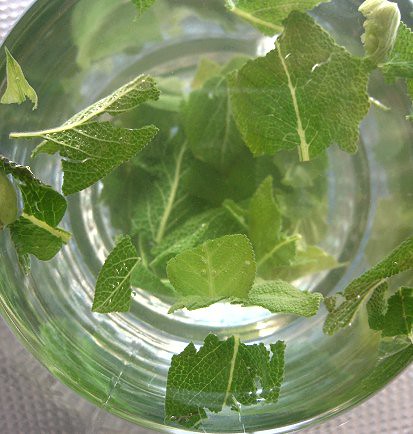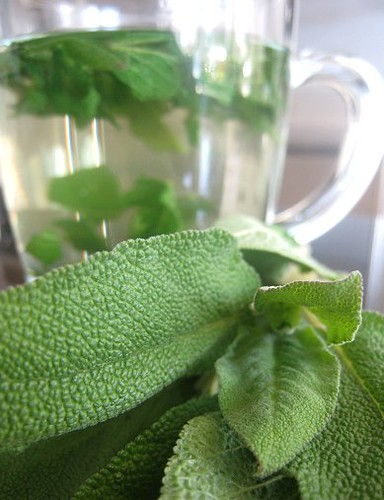
JS:
I guess it's time to accept I just don't have a green thumb.
For two years now, our so-called garden has been languishing. Most everything we've planted in there garden has failed to reach their best, their full potential. From potatoes to cabbage, sugar peas to carrots, nothing blossomed, nothing thrived. I've had half a mind to dig the darn garden up and build a roasting pit instead.
It seems like the only thing that has taken a liking to our plot of land is sage.
It is indeed the garden's salvation, the only plant that has managed to survive and even thrive in what I'm guessing is a very harsh habitat (though I have no idea why that is so). Our sage plant has wonderful and beautiful-looking leaves and the leaves are oh-so-fragrant.
JS:
Unfortunately, save for the occasional roast chicken or roast turkey with sage butter and very infrequent squash-with-fried-sage dishes, we don't use much sage in cooking.
Thankfully, sage has a great many uses other than in cooking.
That above is a sage tea or infusion, made from steeping sage leaves in hot water. Drinking sage tea has numerous health benefits. There has been an exciting new study that shows sage might help in lowering blood sugar.
Apparently, gargling with a sage solution also has benefits, healing mouth ulcers and canker sores and soothing sore throats. Or, at least drinking a sage infusion alleviates the pain associated with these conditions.
Sage has powerful antiseptic properties and can be used to clean wounds. It can also be used as an aftershave, given its astringent properties. Quite surprisingly, it can be used as an antiperspirant due to its moisture-drying properties, although I'm not too clear as to the mechanics of how one can use sage leaves as an antiperspirant.
Pretty nifty plant, wouldn't you say? Sage, yea.
For more information on sage and its numerous beneficial or medicinal qualities, visit these links.
http://www.botanical.com/botanical/mgmh/s/sages-05.html
http://www.gardensablaze.com/HerbSageMed.htm
Enjoyed this post? Why not subscribe to our blog? Subscribe via reader or subscribe via email. Thank you! |
For showcasing SAGE, we're submitting this post to Weekend Herb Blogging, a world-wide food blogging event (created by Kalyn's Kitchen, now maintained by Haalo of Cook (almost) Anything at Least Once) with the goal of helping each other learn about cooking with herbs and plant ingredients.
If you'd like to participate, see who's hosting next week. WHB is hosted this week by Lynne of Cafe Lynnylu.






I adore sage, it is an amazing and healing herb! I haven't made sage tea in a long time, and now I have a hankering for it!
ReplyDeleteI make sage tea sometimes and I served it to some friends once and they liked it too.
ReplyDeleteThat makes two of us...no green thumbs. :O
ReplyDeleteI like sage in stuffing and with butternut squash, never even thought of using it in tea!
ReplyDeleteMy plants are sad, sad, sad!
Thanks for all the info on sage. I use sage in roast chicken and have fried it before as a garnish for butternut squash ravioli, but that's about it. Will have to try the tea. Thanks for joining in WHB#232.
ReplyDeleteJenn:
ReplyDeleteSince I photographed this, I haven't had sage tea in a while as well. There's so much in the garden, I should!
tasteofbeirut:
I thought I invented it. ;)
tigerfish:
I'll just blame the soil. Hehe.
WC:
Really?! But your garden seems to all a-bloom and everything!
LynnyLu:
Thanks for hosting this round-up!
Sage Tea:
ReplyDeleteTo the ancients, including the Arabians, Sage (salvia officinalis) was associated with longevity and was highly prized. The genus name derives from the Latin for salvation . In early Dutch trading days, the Chinese preferred Sage tea to their own native tea, and gave traders up to four times the quantity of their choicest tea in exchange. The American Indians used it both topically and internally for its health benefits. Sage is often used today as a spice for flavoring vegetables, chicken, meats, fish, and eggs. Sage is a heartening brew, if not made too strong. It can be sweetened with maple syrup, brown sugar or honey, or flavored with a squeeze of orange, lemon or a dash of cinnamon. Sage Tea on discount at NutroVita.com.
For more details please visit:
http://www.nutrovita.com/8306/alvita-teas/sage-tea.htm
josephmoss:
ReplyDeleteOK, thanks for the info.